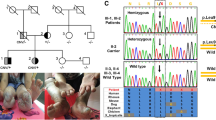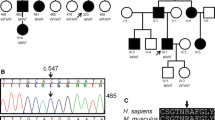Abstract.
Hereditary sensory neuropathy type I (HSN-I) is an autosomal dominant peripheral neuropathy affecting sensory and motor neurons. The disease involves distal sensory loss, distal muscle wasting and weakness, and variable neural deafness. The HSN1 locus has been mapped to a genetic interval of 3-4 cM on chromosome 9q22.1-q22.3 and is flanked by markers D9S1781 and FB19B7. This interval contains the gene NFIL3, a transcription factor that is regulated by the cytokine IL-3. Northern blot analysis of NFIL3 showed a ubiquitously expressed 2.2-kb mRNA. Expression was highest in the lung, with lower levels of expression in the brain and spinal cord. Mutation analysis by direct sequencing of reverse transcription/polymerase chain reaction products from HSN-I patients excluded the coding region of the NFIL3 from being involved in the pathogenesis of HSN-I.
Similar content being viewed by others
Author information
Authors and Affiliations
Additional information
Electronic Publication
Rights and permissions
About this article
Cite this article
Hulme, D., Blair, I., Dawkins, J. et al. Exclusion of NFIL3 as the gene causing hereditary sensory neuropathy type I by mutation analysis. Hum Genet 106, 594–596 (2000). https://doi.org/10.1007/s004390000306
Received:
Accepted:
Published:
Issue Date:
DOI: https://doi.org/10.1007/s004390000306




